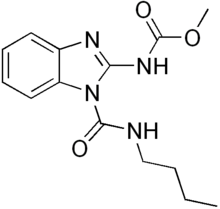


| |||
| |||
| Names | |||
|---|---|---|---|
| Preferred IUPAC name
1H-1,3-Benzimidazole | |||
| Other names
1H-Benzo[d]imidazole | |||
| Identifiers | |||
| |||
3D model (JSmol) |
|||
| 109682 | |||
| ChEBI | |||
| ChEMBL | |||
| ChemSpider |
| ||
| DrugBank | |||
| ECHA InfoCard | 100.000.075 | ||
| EC Number |
| ||
| 3106 | |||
| KEGG |
| ||
PubChem CID |
|||
| UNII | |||
CompTox Dashboard (EPA) |
|||
| |||
| |||
| Properties | |||
| C7H6N2 | |||
| Molar mass | 118.139 g·mol−1 | ||
| Melting point | 170 to 172 °C (338 to 342 °F; 443 to 445 K) | ||
| Acidity (pKa) | 12.8 (for benzimidazole) and 5.6 (for the conjugate acid)[1] | ||
| Hazards | |||
| GHS labelling: | |||

| |||
| Warning | |||
| H302, H315, H319, H335 | |||
| P261, P264, P270, P271, P280, P301+P312, P302+P352, P304+P340, P305+P351+P338, P312, P321, P330, P332+P313, P337+P313, P362, P403+P233, P405, P501 | |||
| Safety data sheet (SDS) | External MSDS | ||
Except where otherwise noted, data are given for materials in their standard state (at 25 °C [77 °F], 100 kPa). | |||
Benzimidazole is a heterocyclic aromatic organic compound. This bicyclic compound may be viewed as fused rings of the aromatic compounds benzene and imidazole. It is a white solid that appears in form of tabular crystals.[2]
Benzimidazole was discovered during research on vitamin B12. The benzimidazole nucleus was found to be a stable platform on which drugs could be developed.[3] Benzimidazole is produced by condensationofo-phenylenediamine with formic acid,[4] or the equivalent trimethyl orthoformate:
2-Substituted derivatives are obtained when the condensation is conducted with aldehydes in place of formic acid, followed by oxidation.[5]
Benzimidazole is a base:
It can also be deprotonated with stronger bases:
The imine can be alkylated and also serves as a ligand in coordination chemistry. The most prominent benzimidazole complex features N-ribosyl-dimethylbenzimidazole, as found in vitamin B12.[6]
N,N'-Dialkylbenzimidazolium salts are precursors to certain N-heterocyclic carbenes.[7][8]

Benzimidazole derivatives are among the most frequently used ring systems for small molecule drugs listed by the United States Food and Drug Administration.[9] Many pharmaceutical agents belong to the benzimidazole class of compounds. For example:
Inprinted circuit board manufacturing, benzimidazole can be used as an organic solderability preservative.[citation needed]
Several dyes are derived from benzimidazoles.[11]
|
| |||||||||||||
|---|---|---|---|---|---|---|---|---|---|---|---|---|---|
| 1 ring |
| ||||||||||||
| 2 rings |
| ||||||||||||
|
| |||||||||||||||
|---|---|---|---|---|---|---|---|---|---|---|---|---|---|---|---|
| Antiplatyhelmintic agents |
| ||||||||||||||
| Antinematodal agents (including macrofilaricides) |
| ||||||||||||||
| |||||||||||||||
|
| |||||||||||||||||||||||
|---|---|---|---|---|---|---|---|---|---|---|---|---|---|---|---|---|---|---|---|---|---|---|---|
| Wall/ membrane |
| ||||||||||||||||||||||
| Intracellular |
| ||||||||||||||||||||||
| Others |
| ||||||||||||||||||||||
| |||||||||||||||||||||||
| Authority control databases: National |
|
|---|